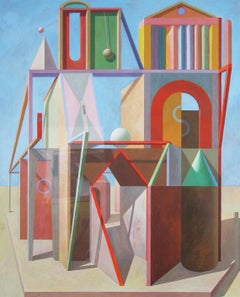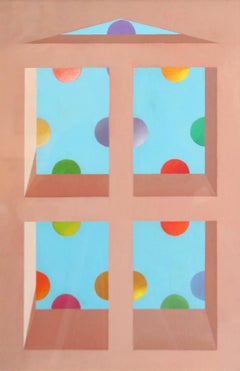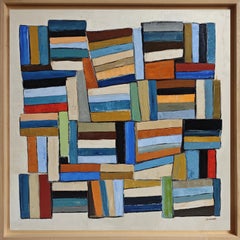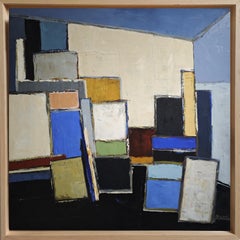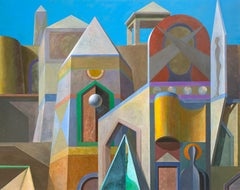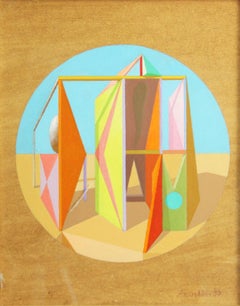Joseph Amarotico Art
to
2
2
2
1
Architectural Fantasies, Geometric Abstract in Color
By Joseph Amarotico
Located in Doylestown, PA
"Architectural Fantasies" is a 40" x 30" gouache on paper, abstract painting of geometric shapes and forms, giving the illusion of a three dimensional, architectural structure.
Born...
Category
1980s Abstract Geometric Joseph Amarotico Art
Materials
Gouache, Archival Paper
Hemispheres, Architectural Abstract, Geometric Forms in Color, Oil on Paper
By Joseph Amarotico
Located in Doylestown, PA
"Hemispheres" is a 20" x 13.5" oil on paper abstract painting of geometric shapes and forms, giving the illusion of a three dimensional, architectural structure. The painting is sign...
Category
Late 20th Century Abstract Geometric Joseph Amarotico Art
Materials
Oil, Archival Paper
Related Items
Pensees entrelacees- Large Abstract Library – Oil on linen canvas –Contemporary
By SOPHIE DUMONT
Located in LANGRUNE-SUR-MER, FR
Title: Pensées Entrelacées
Oil on canvas – 39.37 × 39.37 in (100 × 100 cm)
Framed: 42.13 × 42.13 in (107 × 107 cm) – Natural wood floater frame (black optional)
Signed lower right – ...
Category
21st Century and Contemporary Abstract Geometric Joseph Amarotico Art
Materials
Canvas, Oil
$9,010
H 42.13 in W 42.13 in D 0.79 in
Orchestration d'atelier- Textured Oil Painting, Geometric, Artist Studio, French
By SOPHIE DUMONT
Located in LANGRUNE-SUR-MER, FR
Created by a contemporary French artist recognized for his refined approach to material and abstraction, this painting reflects a deep exploration of memory, silence, and time throug...
Category
21st Century and Contemporary Abstract Geometric Joseph Amarotico Art
Materials
Oil
$5,690
H 34.26 in W 34.26 in D 0.79 in
Tecke, abstract, minimalism, library, oil on canvas, textured, books, French
By SOPHIE DUMONT
Located in LANGRUNE-SUR-MER, FR
framed artwork size 107 x 107 cm (42.12 x 42.12")
unframed size : 100 x 100 cm (3937 x 39.37 in)
Frame: Black or light wood (collector's choice)
Abstraction of books in a library in...
Category
21st Century and Contemporary Abstract Geometric Joseph Amarotico Art
Materials
Oil
$8,725
H 42.13 in W 42.13 in D 1.38 in
Le poids des mots - Abstract library, textured painting, Oil on canvas, french
By SOPHIE DUMONT
Located in LANGRUNE-SUR-MER, FR
About the artist
Sophie Dumont is a French contemporary painter whose work reflects a deep engagement with memory, cultural heritage, and poetic abstraction. Born in Paris in 1964, s...
Category
21st Century and Contemporary Abstract Geometric Joseph Amarotico Art
Materials
Oil
$3,319
H 26.38 in W 26.38 in D 1.38 in
Contemporary abstract expressive painting with shapes and forms "Dialogue"
Located in VÉNISSIEUX, FR
This contemporary abstract painting is part of a collection in soft, neutral earth tones—grey, brown, suede, black, and white—designed to bring calm and harmony to modern interiors.
...
Category
2010s Abstract Geometric Joseph Amarotico Art
Materials
Paper, Acrylic
$310 Sale Price
25% Off
H 25.6 in W 19.69 in D 0.04 in
Sand game 1. 2023, canvas, oil, collage, 50x40 cm
Located in Riga, LV
Sand game 1.
2023, canvas, oil, collage, 50x40 cm
Alyona Prokofyeva (1988)
From 2016 surname Galaktionova. Alyona graduated Riga art school, Latvian University, receiving a visual...
Category
2010s Abstract Geometric Joseph Amarotico Art
Materials
Canvas, Oil, Mixed Media
$663 Sale Price
20% Off
H 19.69 in W 15.75 in D 0.79 in
Contemporary abstract painting earth colors Bursts of Creativity
Located in VÉNISSIEUX, FR
This artwork makes part of my small collection of abstract paintings created in various soft neutral earth tones. Main colors of this collection are grey, brown, suede, black, white....
Category
2010s Abstract Geometric Joseph Amarotico Art
Materials
Paper, Acrylic
$331 Sale Price
20% Off
H 25.6 in W 19.69 in D 0.04 in
April opus. 2018, canvas, oil, 100x80 cm
By Igor Leontiev
Located in Riga, LV
April opus. 2018, canvas, oil, 100x80 cm
Abstract cubist composition in earth colors
Igor Leontiev (1957) - one of the leading independent painters in L...
Category
2010s Abstract Geometric Joseph Amarotico Art
Materials
Canvas, Oil
$1,707 Sale Price
20% Off
H 39.38 in W 31.5 in D 1.19 in
Monumental Abstract Library Painting – Oil on Canvas – The Citadel of Books 2025
By SOPHIE DUMONT
Located in LANGRUNE-SUR-MER, FR
The Citadel of Books is a monumental oil on canvas (59 x 59 inches / 150 x 150 cm) by French contemporary artist Sophie Dumont. This richly textured work features a stylized, six-com...
Category
21st Century and Contemporary Abstract Geometric Joseph Amarotico Art
Materials
Canvas, Oil
$18,968
H 59.06 in W 59.06 in D 0.79 in
Pursuit of Thought — Abstract Minimalism, Textured Oil Painting, Library Series
By SOPHIE DUMONT
Located in LANGRUNE-SUR-MER, FR
Created by a contemporary French artist recognized for his refined approach to material and abstraction, this painting reflects a deep exploration of memory, silence, and time throug...
Category
21st Century and Contemporary Abstract Geometric Joseph Amarotico Art
Materials
Oil
$8,725
H 39.38 in W 39.38 in D 0.79 in
Books symphony, Abstract, library, French Minimalism, Multicolor, Expressionism
By SOPHIE DUMONT
Located in LANGRUNE-SUR-MER, FR
Like a symphony that blends different instruments and musical themes, a library can contain a variety of books representing diverse genres, authors, and subjects. Each book brings i...
Category
21st Century and Contemporary Abstract Geometric Joseph Amarotico Art
Materials
Oil
$1,292
H 18.51 in W 18.51 in D 1.38 in
Yellow tango. 2018, oil on canvas, 90x100 cm
By Igor Leontiev
Located in Riga, LV
Yellow tango. 2018, oil on canvas, 90x100 cm
Abstract composition in red, blue, yellow colors
Igor Leontiev (1957) - one of the leading independent pain...
Category
2010s Abstract Geometric Joseph Amarotico Art
Materials
Canvas, Oil
$2,655 Sale Price
20% Off
H 35.44 in W 39.38 in D 1.19 in
Previously Available Items
Architectural Abstract, Geometric Forms in Color, Modernist Mural, Oil on Canvas
By Joseph Amarotico
Located in Doylestown, PA
"Architectural Abstract" is a 69 x 84 inches, large oil on canvas, abstract mural painting of geometric shapes and forms, giving the illusion of three dimensional, architectural stru...
Category
1980s Abstract Geometric Joseph Amarotico Art
Materials
Canvas, Oil
Tondo Blue, Architectural Surrealism, Geometric Form, Oil on Board, 1980, Signed
By Joseph Amarotico
Located in Doylestown, PA
"Tondo Blue" is a 11.5" x 9.5" oil on board surrealist painting of geometric shapes and forms, giving the illusion of a three dimensional, architectural structure. The painting is si...
Category
1980s Abstract Geometric Joseph Amarotico Art
Materials
Oil, Board
H 15.5 in W 13.5 in D 2 in
Joseph Amarotico art for sale on 1stDibs.
Find a wide variety of authentic Joseph Amarotico art available for sale on 1stDibs. You can also browse by medium to find art by Joseph Amarotico in paint, archival paper, canvas and more. Much of the original work by this artist or collective was created during the 20th century and is mostly associated with the abstract style. Not every interior allows for large Joseph Amarotico art, so small editions measuring 20 inches across are available. Customers who are interested in this artist might also find the work of John Hopwood, Michael Conrads, and Ned Evans. Joseph Amarotico art prices can differ depending upon medium, time period and other attributes. On 1stDibs, the price for these items starts at $2,500 and tops out at $15,000, while the average work can sell for $8,500.
